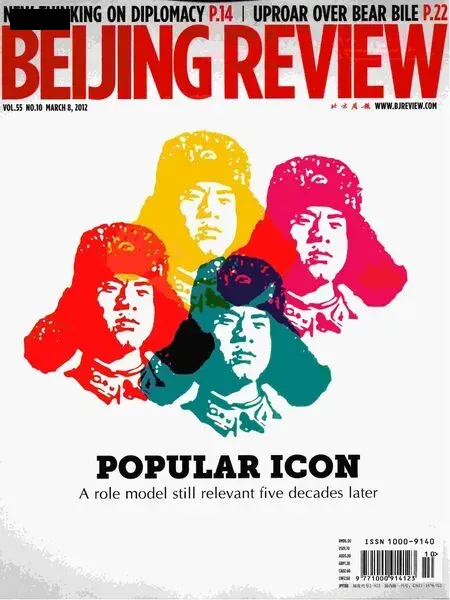MARKET WATCH
MARKET WATCH
OPINION
Breaking the Mengniu Model
Mengniu Dairy Group, a Chinese dairy giant based in the Inner Mongolia Autonomous Region, has been struggling with constant scandals surrounding tainted milk. The root cause lies in the company’s business model focused on marketing over quality control.The only solution is to ditch that model and build agricultural cooperatives that can effectively ensure food safety.
In December 2011, the General Administration of Quality Supervision,Inspection and Quarantine detected excessive amounts of a fl atoxin, a cancer-causing toxin,in some of Mengniu’s pure milk products.The company apologized to consumers on its website, adding that the tainted products had not been on sale and were destroyed already.
The incident was one of the many safety scandals hassling China’s dairy industry in recent years.
There are two major dairy industry associations in the country: the Dairy Association of China (DAC) and China Dairy Industry Association (CDIA). The DAC represents manufacturers in south China that push for pasteurized milk. Pasteurized milk is milk that has been moderately heated to kill pathogens that cause disease. The process is adopted by 95 percent of countries worldwide. In contrast, CDIA represents producers in the north that advocate milk sterilized at ultra-high temperature. It has a long quality guarantee duration and is easier to transport over long distances. In the tussle between the two powers, CDIA won the victory and had a bigger say in the making of the country’s dairy quality standards.
Founded in 1999, Mengniu is a major producer of ultra-high-temperature sterilized milk. It purchases raw milk from farmers and then processes it into a number of dairy products. In only eight years after establishment,the firm built dozens of processing plants across the country. In 2008, the scandal of the notorious melamine, which was blamed for the deaths of at least six children, dealt a heavy blow to domestic dairy companies, including Mengniu.
In a bid to recover its lost ground, Mengniu in late 2008 decided to build grazing lands of its own to ensure clean raw milk supplies. Mengniu said it owns stakes in 14 large grazing lands,which can provide 78 percent of its needed raw milk. But that is doubtful since it is almost impossible to do that in only three years.
More worrying, however, is the fact that Mengniu has put focus on marketing instead of product development. The company spent recklessly on advertisements in newspapers,television and the Internet.
Learning experiences from developed countries, China should encourage the agricultural cooperative system that can effectively lift the dairy industry’s efficiency and product quality. The system is widely used in Denmark, Ireland, Japan, New Zealand and the United States. Even India has set up more than 70,000 dairy cooperatives.
The U.S. dairy cooperatives engage in a variety of activities to provide member farmers with an assured market for their milk.They may negotiate prices and assemble,haul, manufacture, process, or market milk to wholesalers, retailers or in their own stores.Members fi nance the cooperative and share in pro fi ts it earns in proportion to the volume of milk they market through the cooperative.
The United States and European nations help the dairy cooperatives with subsidies and tax waivers. China can also sharpen competitiveness of cooperatives by allowing tax reductions.
THE MARKETS
Shopping Overseas
Chinese consumers spent a record high of $7.2 billion outside the country during the Spring Festival holiday (January 22-28), according to a recent survey by the World Luxury Association.
Europe remained the top destination for luxury shoppers during the seven-day holiday with a 46-percent market share. Chinese tourists contributed 62 percent of luxury sales in Europe during the holiday.
Hong Kong, Macao and Taiwan accounted for 35 percent while north America took the remaining 19 percent, with Chinese travelers contributing one third to its sales.
The association said the Chinese consumers were the biggest luxury buying force during the holiday, with watches, leather goods, fashion clothes and cosmetics topping their shopping lists.
Playing Catch-up
With six of them entering the list of top 10 handset brands in China, domestic cellphone makers had taken a combined market share of 37.5 percent by the end of last year, close to the four big overseas brands’ share of 41.5 percent, according to a recent report by Analysys International, a Beijing-based research fi rm.
The combined market share of the domestic brands—Lenovo, Huawei and ZTE—was only 20 percent at the end of 2010, compared with over 55 percent of the big four overseas brands—Nokia, Samsung, Motorola and LG.
“The change is in part due to weakening dominance of Nokia, and the rapidly growing Android also gave companies a new equal and open platform to develop their products,”said the report.
“In addition, Chinese firms have closely tied up with telecom operators to lure buyers with favorable user packages,” said Wang Yin, a senior analyst with the Analysys International.

